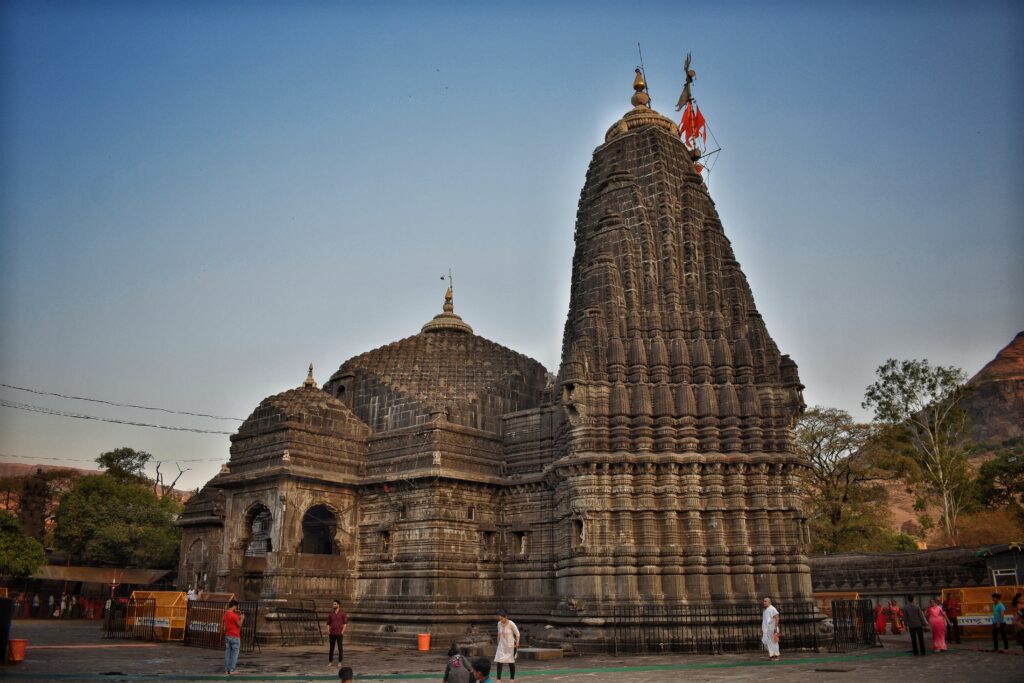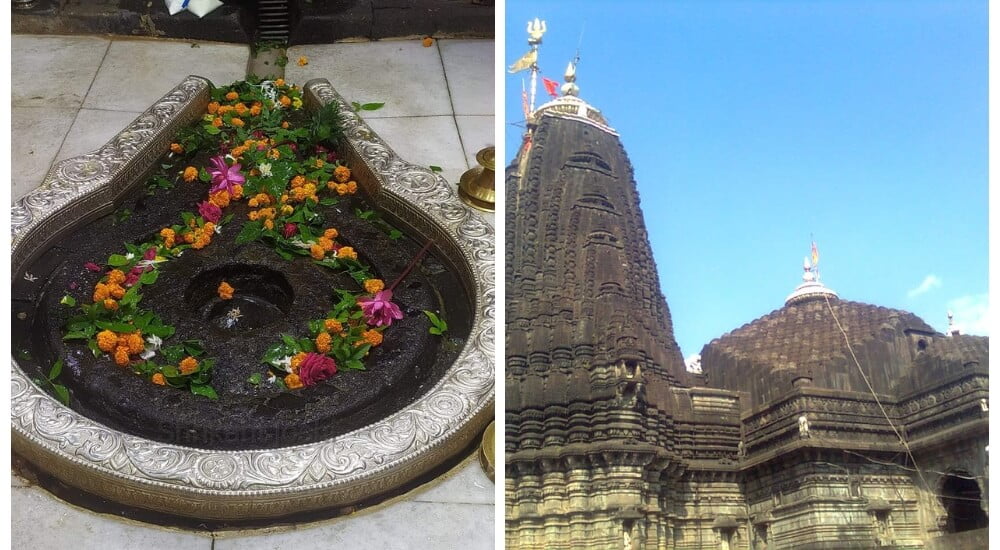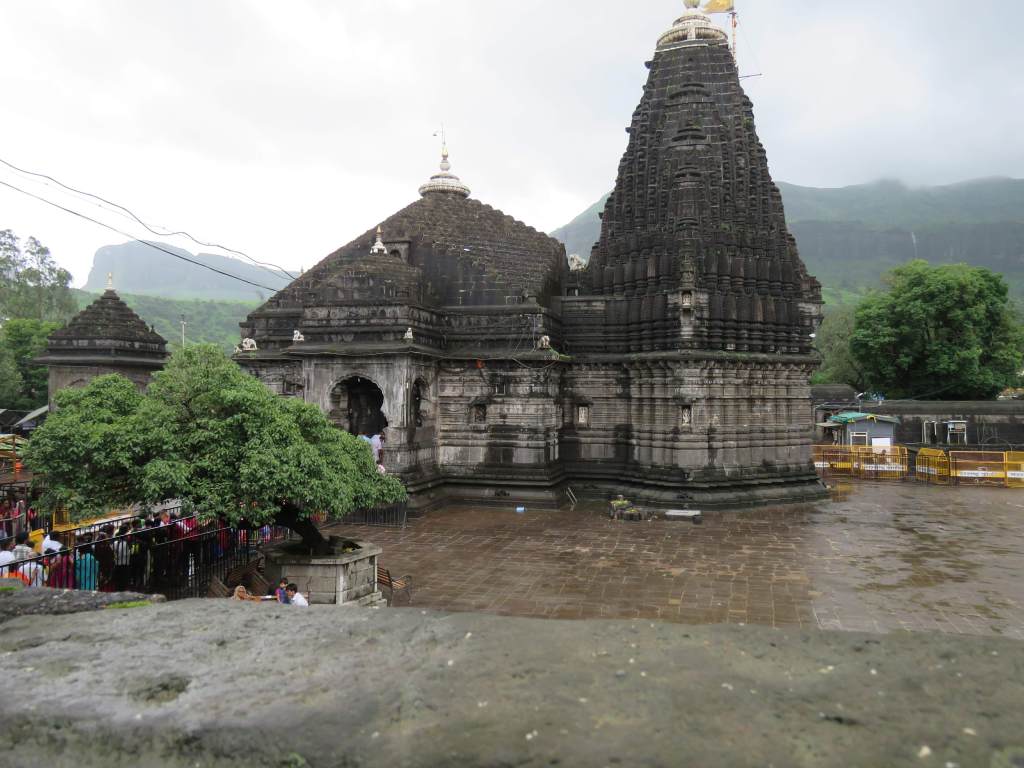
Trimbakeshwar Jyotirlinga, Nashik, Maharashtra
Trimbakeshwar Jyotirlinga is one of the 12 jyotirlingas, sacred shrines dedicated to Lord Shiva in Hinduism. Trimbakeshwar is situated at the source of the Godavari River in the Brahmagiri Hills.
Namaste 🙏 नमस्ते
Secure your visit • अपनी यात्रा सुरक्षित करें
Historical background and Architectural splendor
This Shiva temple was built by the Prime Minister of the Maratha Empire, Peshwa Balaji Baji Rao, also known as Nana Saheb, in the mid-18th century.
Temple is built with black stone and Nagari Style. The temple also has intricate carvings and sculptures depicting scenes from Hindu Mythology.
The trimbakeshwar temple is built with black stone and Nagara style.The temple also has intricate carving and sculptures depicting scenes from Hindu mythology. Temple was inaugurated on 16 th Feb 1756.

Religious Significance
The trimbakeshwar jyotirlinga has three faces representing the Gods – shiva and great religious significance to Hindu and covered by a Jeweled crown that is believed to date to the era of the Pandavas. In ‘Shravan Shivratri Festival’ devotees take a holy dip in the ‘Godavari River’ to cleanse their sins and seek blessing. Devotees believe in liberation from the cycle of birth and death.


Festival and Celebrations
Maha Shivaratri, Kumbh Mela (sinhasth), Shravan Month, Gudi Padava, Kartik Poornima are some of the festivals celebrated in Trimbakeshwar Jyotirlinga.
Surroundings area & attractions
- Godavari River: The Godavari River flows through the vicinity, adding a scenic and serene ambiance to the region. Pilgrims often take holy dips in the Godavari as part of their spiritual journey.
- Kushavarta Kund:This sacred tank, believed to be the source of the Godavari, is an integral part of the Trimbakeshwar pilgrimage. Pilgrims perform rituals and take a dip in the Kund for spiritual purification.
- Anjaneri Hills: Located near Trimbakeshwar, Anjaneri Hills is believed to be the birthplace of Lord Hanuman. The site is known for its trekking trails and panoramic views of the surrounding landscape.
- Gangadwar : A bathing ghat on the Godavari River, Gangadwar is another sacred spot where devotees perform rituals and take holy dips.
- Panchvati, Nashik :Panchvati, associated with the Ramayana, is a pilgrimage site near Trimbakeshwar. Sita Gufa (cave), Kalaram Temple, and Sita Gumpha are some of the notable attractions in Panchvati.
- Sita Gufa :Located in Panchvati, Sita Gufa is believed to be the cave where Sita, the wife of Lord Rama, stayed during their exile.
Visitor information
Entry Fee: No fee
Timings :
- Monday to Thursday 6 am to 9 pm
- Friday to Sunday 5.30 am to 9 pm
Darshan Days- All days
Notable Events and Incidents
- Maha Shivaratri Observance
- Guru Purnima Shahi Snan
Connectivity :
- By Train - Trimbakeshwar is 40 km away from Nashik road railway station.
- By Bus - Trimbakeshwar is 27 km from Nashik central bus stand.
- By Air - The nearest airport is Gandhinagar Airport in Nashik.Fly Mumbai airport to domestic Nashik airport.
FAQ
The Trimbakeshwar Jyotirlinga is located near the town of Trimbak in the Nashik district of Maharashtra, India.
The presiding deity of the Trimbakeshwar Jyotirlinga is Lord Shiva, worshiped in the form of Trimbak or Trimbakeshwar.
The Trimbakeshwar Jyotirlinga is one of the twelve Jyotirlingas, which are considered the most sacred abodes of Lord Shiva. It holds great religious and spiritual significance for Hindu devotees.
The history of the Trimbakeshwar Jyotirlinga dates back to ancient times and is associated with various legends and myths. It is believed to have been established by Lord Brahma, and later rediscovered by Sage Gautama.
The Trimbakeshwar Temple exhibits a blend of architectural styles, including the Hemadpanti style of architecture prevalent in Maharashtra. It is characterized by its stone walls, domes, and intricately carved pillars.
The Trimbakeshwar Temple follows a strict schedule of rituals and ceremonies dedicated to Lord Shiva. These include daily puja (worship), abhishekam (ritual bathing of the deity), aarti (ritual of worship with lamps), and special festivities during Mahashivratri and other auspicious occasions.
Yes, the Trimbakeshwar Jyotirlinga is situated at the source of the Godavari River, which is considered sacred by Hindus. The temple’s location adds to its spiritual significance and attracts pilgrims from far and wide.
The Kusavarta Kund is a sacred tank located near the Trimbakeshwar Temple, believed to be the origin of the Godavari River. Devotees consider bathing in the Kusavarta Kund to be highly auspicious and purifying.
Yes, the Trimbakeshwar Temple is open to visitors of all faiths and backgrounds. Non-Hindus are welcome to explore the temple complex and experience its spiritual ambiance.
Nashik offers several other attractions for visitors, including other temples, historic sites, and natural landscapes. Some notable attractions include the Sula Vineyards, Pandavleni Caves, and the Dudhsagar Waterfalls.
The Trimbakeshwar Jyotirlinga is one of the twelve Jyotirlingas, which are considered the most sacred abodes of Lord Shiva. It is believed that worshipping the Jyotirlinga at Trimbakeshwar grants devotees spiritual liberation and fulfillment of desires.
The Trimbakeshwar Jyotirlinga is situated in the town of Trimbak near Nashik in the state of Maharashtra, India.
The Trimbakeshwar Temple showcases traditional Hindu temple architecture with influences from the Hemadpanthi style, characterized by its stone-carved walls, ornate sculptures, and intricate designs.
Apart from the main deity of Lord Shiva in the form of Trimbakeshwar Jyotirlinga, the temple also houses shrines dedicated to Goddess Parvati, Lord Vishnu, and other deities of Hindu mythology.
The Trimbakeshwar Temple follows a rigorous schedule of daily rituals and ceremonies, including abhishekam (ritual bathing) of the Jyotirlinga, pujas, aartis (worship with lamps), and special offerings made by devotees seeking blessings.
Trimbakeshwar is one of the four locations where the Kumbh Mela, a massive Hindu pilgrimage and festival, is held in rotation every twelve years. During the Kumbh Mela, millions of devotees gather to take a holy dip in the sacred Godavari River and seek spiritual purification.
According to Hindu mythology, the Trimbakeshwar Jyotirlinga is associated with several legends, including the story of Lord Shiva bestowing water upon the earth from his matted locks, thus giving rise to the Godavari River.
Nashik is home to several other temples, historical sites, and natural attractions that visitors can explore along with the Trimbakeshwar Temple. Some attractions include the Panchavati area, Ram Kund, Sita Gufa, and the vineyards of Nashik.
Yes, visitors have the opportunity to participate in various special rituals and ceremonies conducted at the Trimbakeshwar Temple, such as Rudrabhishekam, Laghurudra, and Panchamrut Abhishekam, for seeking blessings and spiritual fulfillment.
While there is no strict dress code, visitors are encouraged to dress modestly and respectfully while visiting the Trimbakeshwar Temple. Additionally, footwear should be removed before entering the temple premises, and devotees are expected to maintain silence and reverence.
